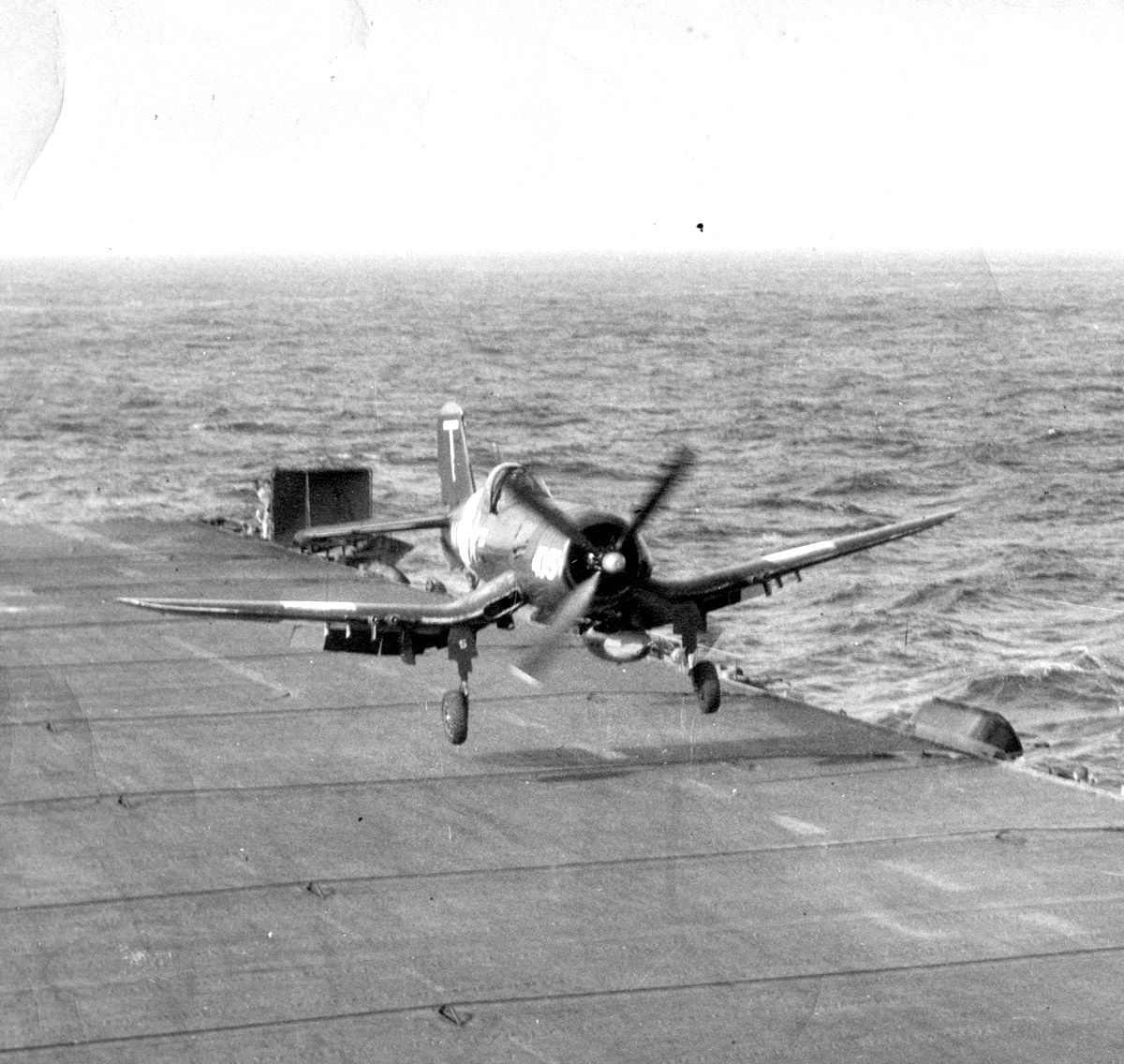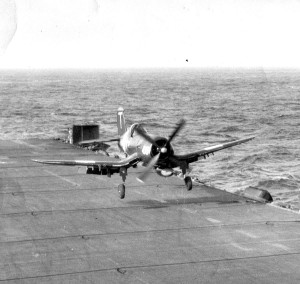By Fred
I’ve previously written about flying the F4U Corsair in the early 1950s for the U.S. Navy in the early 1950s. During 262 Corsair flights, I had four accidents, making me more than 98 percent safe! This is the story of my 263rd–and last–Corsair flight.
It has been said that the most dangerous time in a pilot’s career is when he has about 600 flying hours. Prior to that time, he’s very careful and deliberate. After about 600 hour’s flight time, he tends to be more relaxed–and gets careless. I had 666.2 hours, with 454.6 hours in F4U Corsairs, when I crashed on the deck of an escort carrier!
It was a bright, clear dawn in the Caribbean on Nov. 7, 1951, when eight of us in Fighter Squadron Fourteen (VF-14) were shot (they called it “catapulted”!) from the straight-deck escort carrier USS Kula Gulf (CVE-108.) Our F4U-5 Corsairs were part of an annual training exercise called LANTFLEX (AtLANTic FLeet EXercise.) We were the Red Squadron, flying Combat Air Patrol to protect our small task force from any Blue (enemy) raids.
Nothing special happened. We just flew around in large, lazy circles in loose formation over the endless sparkling water, some distance from the carrier and its support vessels. I was flying F4U-5 Navy serial #122158, Squadron #405.
After more than two hours of occasional vectoring by the carrier Combat Information Center, we headed back “home.” We flew in right echelon past the starboard side of the carrier’s island, as we peeled off to port, setting our landing interval. We landed in turn without incident, and headed for the ready room. The acey-deucey (backgammon to landlubbers) and card games came out, and we relaxed. After our early launch and relatively long 2.6-hour flight, I wasn’t scheduled for any other flights that day.
It was late morning when things suddenly changed! The ship’s radar had spotted a “snooper,” apparently a Blue patrol plane approaching our ships.
“Pilots, man your planes!” was called for those scheduled on standby. I wasn’t scheduled to fly, and our deck wasn’t spotted for the unexpected launch, but I went up on deck in case I was needed to taxi a plane to a new position.
It soon became apparent that some of our planes would have to be moved. I climbed into the same #405 I had flown earlier, expecting to taxi around the flight deck as directed, while re-spotting aircraft. I had my regular flight gear–a hardhat, G-suit and parachute, standard procedure in case of a standby launch–but no plotting board and no briefing.
This was to be a four-plane search-and-destroy mission. Three planes got off fine, but the fourth had engine trouble. All planes were being catapulted, since the wind over the short deck wasn’t sufficient for a safe deck launch. (Not that cat shots were all that safe!)
They took the sputtering, dud Corsair off the port catapult, put me on, hooked up the shuttle and cable, and shot me into the gathering clouds! Equipped with an extra gas tank, I was off for a three-hour search flight.
This turned out to be a long, boring, very tiring flight. To make things more interesting, the flight leader put us in a “tail chase.” I was the last plane in this whipping tail, as the leader performed mild aerobatics. The idea was to stay in position behind the plane ahead of you. Following was relatively easy if you were in one of the up-front positions, but it got progressively more difficult if you were further back in the stack.
I was in position #4, the end of the tail, and was using lots of throttle, rudder, elevator and aileron movement, trying to stay in position. (This wasn’t as bad as being in the #8 position in a tail-chase, as I had been a number of times, but it was grueling, nevertheless.)

Although I got my tail down and caught the last arresting wire, the first barrier cables bent two blades of the prop.
The F4U-5, the heaviest in the Corsair series, didn’t have boosted controls, and didn’t need them for normal flight. But it took a lot of physical effort to horse it around the sky. Also, we had gone up above the cloud layer, and the sun was beating through the bubble canopy. Combined with the natural high humidity of the Caribbean, the inside of that bird was hot and sticky! I recall trying to cool off by popping the canopy back a few inches several times.
Finally, after three hours, we were called back for landing. Another unscheduled launch had taken place while we were airborne, so the deck had been re-spotted again for our recovery. Those were still the days of straight-deck carriers, when reshuffling planes on deck was a common and necessary procedure between launches and recoveries.
We spotted the Kula Gulf, steaming ahead of its bubbling, churning wake, surrounded by several smaller support vessels and their smaller, shorter white tails, which contrasted against the shimmering sea. A rescue helicopter, always aloft during air operations, hovered nearby.
As we approached the landing pattern in right echelon formation, flying upwind along the starboard side of the carrier for the break-off, I reflected about how well I had been doing. I mentally patted myself on the back for my good ordnance scores. Although there had been a rash of accidents on this cruise, my slate was clean.
Landing an F4U-5 on a small escort carrier was inherently marginal. Escort carriers (CVEs), with a flight deck about 500 feet long, were small compared to the larger 800- and 1,000-foot light (CVL) and battle (CV) carrier decks. Escort carriers had fewer arresting wires (as I recall, eight wires compared to 11 for CVLs and 13 for CVs), and their top-heavy decks on small hulls had much greater tendencies to pitch, yaw and roll, even in light seas. Every landing was a challenge.
As I peeled off to the left and set my interval for the downwind leg, I looked forward to getting down. I was very tired and sweaty. Getting back on deck, into a shower, and then sacking out–that’s what I was planning.
I dropped my wheels, flaps and hook on the downwind leg, throttled back to lose some altitude, and used the ship and its wake to judge my abeam position, direction and altitude. The ship was steaming upwind, and I was flying downwind, so it took no time at all before it was time to turn left onto the base leg.
I pulled back on the throttle, slowly dropping altitude on the base leg by referring to where the horizon cut the bridge. I finally settled at the approach altitude and maintained just enough power to hold the nose-up attitude at about 90 knots, hanging on the prop. I put the left nose of the Corsair on the aft starboard deck for an intercept course and held it there. As the ship moved forward at about 20 knots, I pulled the Corsair around to the left, watching the landing signal officer for paddle instructions.
There was no luxury of any significant straightaway in landing on those old straight-deck carriers when you were flying a long-nose Corsair in a nose-up attitude. You just couldn’t see ahead of you–only off to the side. We essentially “pyloned” counterclockwise around the LSO, in order to keep him in sight at his port fantail location.
As I got close in, I pulled the nose left toward the ship’s centerline. The wind over the deck affected this. The wind was never straight down the deck, but about 10 degrees to port, so the turbulence from the ship’s stacks and bridge didn’t appear in the flight path of the landing planes. This made for a very tricky last few seconds.
At this slow speed, just a few knots above stalling, it took a lot of right rudder, even though you were in a left turn. And you didn’t dare add power quickly–even if you thought you had to–since the 2,300-hp engine turning the 14-foot diameter four-bladed prop could make the aircraft roll uncontrollably to the left–the dreaded torque roll.
It took a lot of back stick, considerable power, and almost all my right rudder to hang in there. As I approached the ramp in a left turn, the LSO’s paddles and my own perception was that I was drifting to the right of the deck centerline. Too much right rudder. I corrected a bit and slipped to the left, just as I approached the ramp, leveled my wings, and got a mandatory “cut.”
“Ah, home at last,” I thought as I relaxed. I dropped the nose and pulled back to drop the tail, so my hook would catch an early wire. But I didn’t pull back soon enough, and my wheels hit the deck and bounced. I was flying over the arresting wires, tail up, and drifting to the left!
I heard the crash horn just as I popped the stick forward to get back on deck, and then quickly pulled back to get my arresting hook down. I caught #8, the last arresting wire. But with the heavy Corsair, the arresting wire pulled out just enough for the prop to catch the uplifted first barrier cables. Strike two prop blades!
A quick eye exam showed that I had developed astigmatism in both eyes, and had lost my depth perception. I hadn’t known where the deck was! This ended my military flying career, but–using corrective lenses–I qualified for a commercial pilot license in 1953, and have flown many times in many different aircraft since then–without another accident.
Fred’s two flying books, “Bent Wings–F4U Corsair Action & Accidents: True Tales of Trial & Terror!” and “Flying With the Fred Baron” are available at [http://www.amazon.com] or [http://www.bn.com].












